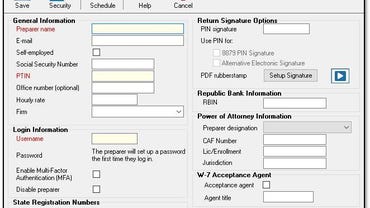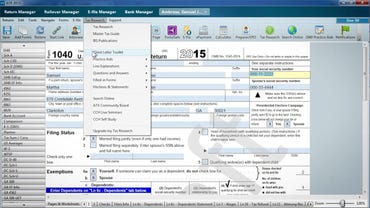Are you a tax preparer who is looking for the best software for tax preparers? You’ve come to the right place. If you are tired of being limited by your current software, then read on!
If you’re a tax preparer, then it’s important to find the best tax software for your business. There are many pieces of software out there that claim to help you with taxes, but some of them just aren’t that great at helping you prepare taxes.
Drake Tax
For tax professionals
Drake Tax is generally known for being the tax software that offers the best value for tax professionals serving primarily mid-market clients with more complex tax circumstances and some small businesses. It is also known for providing several streamlined electronic filing features, including SecureFilePro. Let’s take a look at why it remains one of the best choices for tax preparers.
Features
Drake Tax is consistently on the list for best tax software because of its ease of use, simple navigation, and highly-rated customer service. Some of its most attractive features include simplified data entry, automatic data flow from various federal and state returns, and automatic forms filing, just to name a few. Various tax-year analyses make Drake Tax a great choice for tax preparers. Features include:
- Extensive filing: Drake Tax supports simple and complicated filers. It is popular among CPA firms with small and mid-size clients and includes all relevant forms, such as 1040 forms, those for partnerships, C and S-corps, trusts and estates, and tax-exempt organizations. Drake Tax supports the following tax forms and schedules: 1040, 1040 NR, 1065, 1120, 1120S, 1120H, 706, 709, 990, 1041.
- SecureFilePro and paperless options: SecureFilePro, which has a dedicated paperless feature, allows users to electronically obtain source documents from their clients that they will use in the tax preparation process. E-filing and an e-signature component can facilitate an even smoother tax preparation process that can be done completely electronically.
- Ease of data import: With Drake Tax, users can easily import QuickBooks or Client Write-Up data. This also makes importing spreadsheets quick and efficient.
- Planning and review tools: Drake Tax allows users to compare taxes from one year to the next, making tax planning easy. Archived information is made readily available in the user dashboard, and amortization scheduling is also available. Additionally, Drake Tax has built-in features to prevent oversights that could lead to IRS rejections if you make a mistake.
Pricing options
Drake Tax offers two platforms: A desktop version and a web-hosted version called Drake Tax in the Cloud.
Price range: The desktop version is between $330 and $1,695. The cloud version is $99 per month per user plus the purchase of a software license.
ATX Tax
Pay-per-return system
ATX is a professional tax software by Wolters Kluwer. It has a vast and comprehensive tax form library with over 6,000 tax compliance forms and business returns, making it a great choice for small- to medium-sized businesses serving corporate and business clients.
Features
- Ease and diagnostics: In past surveys in the Tax Advisor, ATX has rated at the top for “easiest to use” tax software programs. Furthermore, ATX’s robust diagnostic system identifies e-filing errors, overridden entries, and even omissions. Tracking refunds or balances due is easy with the Refund Meter feature.
- Extensive form library: ATX has over 6,000 forms, mostly federal, state, and local returns and corresponding schedules. In addition to specialty returns (706, 709, 990, 550), ATX also houses forms for state and federal sales and use tax.
- Abundant research: Accessing IRS form instructions and schedules is relatively straightforward and simple. Most of the ATX packages include award-winning research resources, such as CCH AnswerConnect and CCH US Master Tax Guide.
- Integration: Important data from QuickBooks Online is easy to import with ATX. ATX integrates with CCH iFirm Portal, offering seamless and secure file sharing of uploaded documents.
Pricing options
Per ATX, the most popular package is ATX MAX for $1,929.
Price range: ProSeries Professional costs between $629 and $4,699, depending on which package you choose. ATX Pay-Per-Return is the least costly, and ATX Advantage is the most costly.
 |
| FREE EDITION $0 (federal) | $0 (state)What H&R Block Free can do: 1040 and schedules 1 & 3, income from wages (W-2), income from bank interest (1099-INT) and dividends (1099-DIV), student loan interest (1098-E).What it can’t do: Itemized deductions (Schedule A), deductions and expenses from freelance or self-employed work (Schedule C), HSA distributions (1099-SA). |
| GET STARTED WITH H&R BLOCK(or read our review) |
Like the free tax software from most of its competitors, H&R Block Free lets you file Form 1040. But H&R Block’s free version also lets you file schedules 1 and 3, which is a big bonus because many taxpayers need to file those forms to report things such as business income, alimony, certain retirement contributions, the credit for dependent care expenses, the Lifetime Learning Credit or the Saver’s Credit. You may need to upgrade if you don’t know how much to claim for those things and want the software to calculate it for you.
Also, if you plan to itemize deductions, were a landlord, freelanced or ran a small business or had any other situations going on, you’ll probably need to upgrade to one of H&R Block’s paid packages.
H&R Block’s interface is visually simple, straightforward and easy to use, and it steps up to explain concepts as you go. Skipping around to specific spots can be a little tricky, but a banner across the top keeps track of where you stand in the filing process.
Conclusion
In today’s digital day and age, tax preparation software is a reality. Tax accountants who want to excel in their business need to take into consideration that software can be both a cost-time saver and a liability protection tool. In the past, tax professionals kept all of their information in their head and in boxes marked with year names. The one thing they couldn’t take back home without losing it was the paperwork. The tax code was a lot different in those days, and a lot simpler too.


